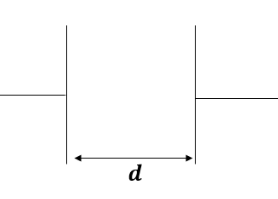
An infinite nonconducting sheet has a surface charge density $\sigma = 0.10\mu C/{m^2}$ on one side. How far apart are equipotential surfaces whose potentials differ by $50V$?
A. $8.8mm$
B. $8.8cm$
C. $8.8m$
D. $8.8\mu m$
Answer
550.2k+ views
Hint: Potential of a charge conducting field is the product of the electric field and the distance between the parallel plates of the charged conductors. And the electric field on an infinite sheet is the ratio of its charge density to the relative permittivity.
Formula Used: $V = Ed$
Where,
$V = $ Potential
$E = $ Electric field
$d$ is the separation between the plates of the charged conductor
$E = \dfrac{\sigma }{{2{\varepsilon _0}}}$
Where,
$E$ is electric field due to infinite sheet
$\sigma $ is the surface charge density
${\varepsilon _0}$ is the relative permittivity of free space
Complete step by step answer:Observe the diagram

We know that, for an infinite charged sheet
$E = \dfrac{\sigma }{{2{\varepsilon _0}}}$
and $V = Ed$
where,
$E$ is electric field
${\varepsilon _0} = 8.85 \times {10^{ - 12}}{C^2}{N^{ - 1}}{m^{ - 2}}$ is the permittivity of free space
$\sigma $ is surface charge density of the sheet
$V$ is potential
$d$ is separation between the sheets
Substituting the value of $E$ into the equation of $V$ we get
$V = \dfrac{{\sigma d}}{{2{\varepsilon _0}}}$
By rearranging it, we get
$d = \dfrac{{2V{\varepsilon _0}}}{\sigma }$
It is given to us that,
$\sigma = 0.10\mu C/{m^2}$
$ \Rightarrow \sigma = 0.10 \times {10^{ - 6}}C/{m^2}$
$ \Rightarrow \sigma = {10^{ - 7}}C/{m^2}$
$V = 50V$
Substituting these values in the above equation, we get
$d = \dfrac{{2 \times 50 \times 8.85 \times {{10}^{ - 12}}}}{{{{10}^{ - 7}}}}$
by simplifying it we get
$d = 100 \times 8.85 \times {10^{ - 5}}$
$ = 8.85 \times {10^{ - 3}}m$
$ \Rightarrow d = 0.88mm$
Therefore from the above explanation the correct option is (B) $8.8cm$
Note:Any surface over which the potential is constant is called an equipotential surface. In other words, the potential difference between any two points to an equipotential surface is zero. For this question, we considered the relativity of free space and it was not mentioned that there is any dielectric between the plates. But it is not always necessary. Sometimes, you might have a dielectric between the plates. Then the formula of electric field will be
$E = \dfrac{\sigma }{{2\varepsilon }}$
Where, $\varepsilon $ is the permittivity of dielectric.
Formula Used: $V = Ed$
Where,
$V = $ Potential
$E = $ Electric field
$d$ is the separation between the plates of the charged conductor
$E = \dfrac{\sigma }{{2{\varepsilon _0}}}$
Where,
$E$ is electric field due to infinite sheet
$\sigma $ is the surface charge density
${\varepsilon _0}$ is the relative permittivity of free space
Complete step by step answer:Observe the diagram

We know that, for an infinite charged sheet
$E = \dfrac{\sigma }{{2{\varepsilon _0}}}$
and $V = Ed$
where,
$E$ is electric field
${\varepsilon _0} = 8.85 \times {10^{ - 12}}{C^2}{N^{ - 1}}{m^{ - 2}}$ is the permittivity of free space
$\sigma $ is surface charge density of the sheet
$V$ is potential
$d$ is separation between the sheets
Substituting the value of $E$ into the equation of $V$ we get
$V = \dfrac{{\sigma d}}{{2{\varepsilon _0}}}$
By rearranging it, we get
$d = \dfrac{{2V{\varepsilon _0}}}{\sigma }$
It is given to us that,
$\sigma = 0.10\mu C/{m^2}$
$ \Rightarrow \sigma = 0.10 \times {10^{ - 6}}C/{m^2}$
$ \Rightarrow \sigma = {10^{ - 7}}C/{m^2}$
$V = 50V$
Substituting these values in the above equation, we get
$d = \dfrac{{2 \times 50 \times 8.85 \times {{10}^{ - 12}}}}{{{{10}^{ - 7}}}}$
by simplifying it we get
$d = 100 \times 8.85 \times {10^{ - 5}}$
$ = 8.85 \times {10^{ - 3}}m$
$ \Rightarrow d = 0.88mm$
Therefore from the above explanation the correct option is (B) $8.8cm$
Note:Any surface over which the potential is constant is called an equipotential surface. In other words, the potential difference between any two points to an equipotential surface is zero. For this question, we considered the relativity of free space and it was not mentioned that there is any dielectric between the plates. But it is not always necessary. Sometimes, you might have a dielectric between the plates. Then the formula of electric field will be
$E = \dfrac{\sigma }{{2\varepsilon }}$
Where, $\varepsilon $ is the permittivity of dielectric.
Recently Updated Pages
A man running at a speed 5 ms is viewed in the side class 12 physics CBSE

The number of solutions in x in 02pi for which sqrt class 12 maths CBSE

State and explain Hardy Weinbergs Principle class 12 biology CBSE

Write any two methods of preparation of phenol Give class 12 chemistry CBSE

Which of the following statements is wrong a Amnion class 12 biology CBSE

Differentiate between action potential and resting class 12 biology CBSE

Trending doubts
What are the major means of transport Explain each class 12 social science CBSE

Which are the Top 10 Largest Countries of the World?

Draw a labelled sketch of the human eye class 12 physics CBSE

How much time does it take to bleed after eating p class 12 biology CBSE

Explain sex determination in humans with line diag class 12 biology CBSE

Explain sex determination in humans with the help of class 12 biology CBSE




